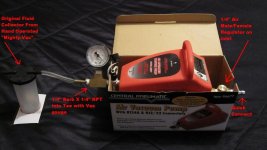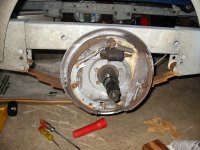Today I replaced my brake fluid and am happy to report the results.
The compressor is powered up and connected to the apparatus.
After breaking the bleeder nut free with a 3/8" brake-line wrench, I slipped the 1/4" vinyl tubing over the nipple. Opening the air supply valve on the compressor side of the apparatus initiated a nice steady vacuum(-15 in. hg) that sealed the vinyl hose to the nipple firmly. 1/4 turn on the bleeder started the fluid transfer into the collector vessel. At this point I got up and drank coffee while the process continued.
Totally hands off!
After a bit I closed the bleeder and then the air supply valve so I could empty the collector of the old fluid. Then I topped off the reservoir(at the surge assembly) with fresh fluid and repeated the process. Once I had clear fluid emerging from the bleeder I tightened it up and moved on to the next brake. That's it. The constant, relentless vacuum eliminated any possibility of air entering the system and relieved me of continually pumping away at a Mightvac as I did before. Unbelievably, I managed to complete this process without spilling even a single drop of fluid at the bleeders.
All in all the $20 was well spent. It made a messy and tedious job a much more pleasant experience.




